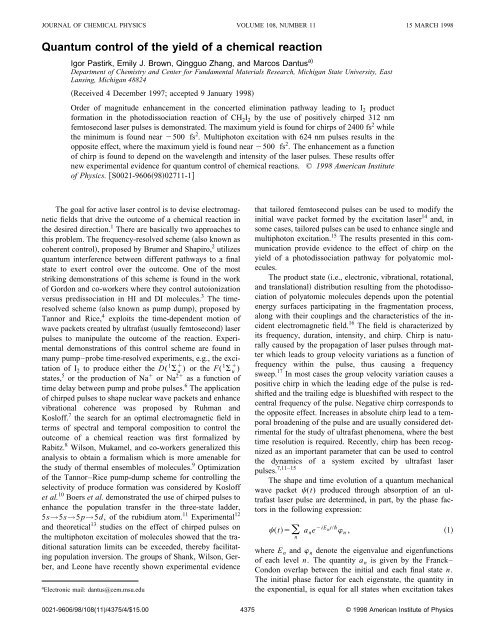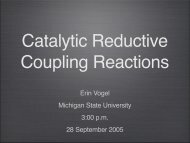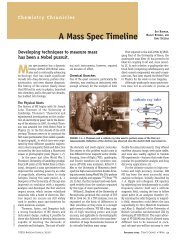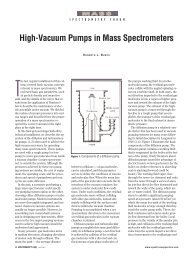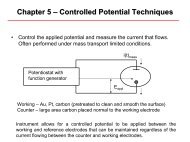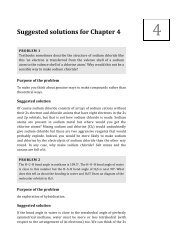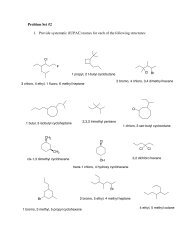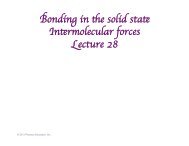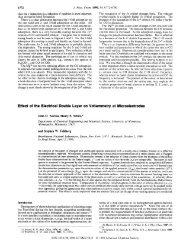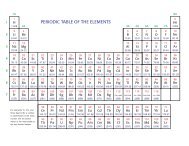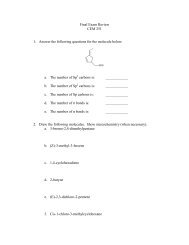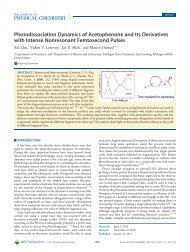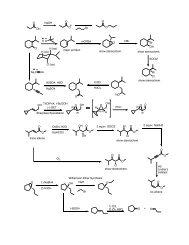Quantum control of the yield of a chemical reaction - Department of ...
Quantum control of the yield of a chemical reaction - Department of ...
Quantum control of the yield of a chemical reaction - Department of ...
You also want an ePaper? Increase the reach of your titles
YUMPU automatically turns print PDFs into web optimized ePapers that Google loves.
4376 J. Chem. Phys., Vol. 108, No. 11, 15 March 1998 Communicationsplace with transform limited pulses, i.e., no chirp. However,chirped pulse excitation opens <strong>the</strong> possibility for introducingdifferent initial phases. Therefore, <strong>the</strong> shape and dynamics <strong>of</strong><strong>the</strong> wave packet can be <strong>control</strong>led by chirped pulses with <strong>the</strong>goal <strong>of</strong> affecting <strong>the</strong> outcome <strong>of</strong> a <strong>chemical</strong> process. 7,14,15The following experiments were carried out with ahomebuilt femtosecond laser system consisting <strong>of</strong> a collidingpulse mode-locked dye laser CPM pumped by an Ar laser.The CPM output was amplified in a pulsed dye amplifier.The amplified pulses were compressed by a two-prism,double-pass pulse compressor. The laser system producedpulses with 47 fs temporal width and with <strong>the</strong> central wavelengthat 624 nm. Typical pulse energy was 0.4 mJ 30 Hzrepetition rate, but was attenuated for <strong>the</strong> experiments to 70J. In cases where 312 nm femtosecond pulses were necessary,<strong>the</strong> 624 nm beam was frequency doubled by a KDPcrystal 0.1 mm producing 7 J pulses. The pulses were<strong>the</strong>n focused into a quartz cell containing <strong>the</strong> gaseoussample. Fluorescence signals originating from <strong>the</strong> cell werecollected along <strong>the</strong> direction perpendicular to <strong>the</strong> laser beampropagation through a 0.27 m spectrometer. The laser intensity<strong>of</strong> <strong>the</strong> 312 nm beam was continuously monitored by aphotodiode.One <strong>of</strong> <strong>the</strong> compression prisms was mounted on acomputer-<strong>control</strong>led actuator. Translation <strong>of</strong> <strong>the</strong> prism alongits bisector varied <strong>the</strong> amount <strong>of</strong> glass through which <strong>the</strong>beam propagated and permitted <strong>the</strong> introduction <strong>of</strong> linearchirp. Because <strong>the</strong> amount <strong>of</strong> chirp was computer <strong>control</strong>led,scans <strong>of</strong> signal intensity as a function <strong>of</strong> chirp could beachieved in a convenient and fast manner. Characterization<strong>of</strong> <strong>the</strong> femtosecond pulses was carried out by frequency resolvedoptical gating FROG. 18 FROG measurements in ourlaboratory provided direct measurements <strong>of</strong> <strong>the</strong> frequencycomponents <strong>of</strong> each pulse as a function <strong>of</strong> time, from which<strong>the</strong> linear chirp was determined. A continuous chirp scale asa function <strong>of</strong> prism position was compiled using <strong>the</strong> expressionfor group velocity dispersion as a function <strong>of</strong> prismposition derived by Fork et al. 19 and simplified by Salin andBrun. 20Quartz cells containing iodine, I 2 , or methylene iodide,CH 2 I 2 Aldrich 99%, were prepared on a vacuum line, andwere degassed to less than 10 6 Torr. Iodine scavengingagents sodium thiosulphate and copper were introduced in<strong>the</strong> CH 2 I 2 cell to ensure that <strong>the</strong> signal derived only fromnascent iodine. Experiments were carried out at room temperature21 °C with vapor pressures <strong>of</strong> 0.25 and 1.2 Torrfor I 2 and CH 2 I 2 , respectively.Spectral pr<strong>of</strong>iles for <strong>the</strong> 624 and 312 nm pulses measuredat zero, negative, and positive chirps were obtained inorder to experimentally confirm that <strong>the</strong> introduced chirp didnot affect <strong>the</strong> spectrum <strong>of</strong> <strong>the</strong> pulses. The intensity variations<strong>of</strong> <strong>the</strong> 624 and 312 nm pulses as a function <strong>of</strong> chirp were alsomeasured. The intensity <strong>of</strong> <strong>the</strong> fundamental remained essentiallyconstant; whereas, a small variation in <strong>the</strong> UV intensitywas observed. This variation can be understood in terms <strong>of</strong><strong>the</strong> dependence <strong>of</strong> second-harmonic generation on <strong>the</strong> peakintensity <strong>of</strong> <strong>the</strong> incoming pulses. As absolute chirp increases,<strong>the</strong> pulse width increases resulting in a reduction <strong>of</strong> peakintensity.FIG. 1. a Experimental measurement <strong>of</strong> <strong>the</strong> <strong>yield</strong> <strong>of</strong> <strong>the</strong> molecular pathwayproducing I 2 from <strong>the</strong> multiphoton dissociation <strong>of</strong> CH 2 I 2 with 624 nmlaser pulses as a function <strong>of</strong> chirp. The insert shows <strong>the</strong> relevant energeticsfor <strong>the</strong> <strong>reaction</strong>. b Same as a except for I 2 .The concerted elimination <strong>of</strong> I 2 molecules following irradiation<strong>of</strong> CH 2 I 2 is known to occur for excitation energieslarger than 9.4 eV. 21 The <strong>yield</strong> <strong>of</strong> this molecular processhas been measured to be on <strong>the</strong> order <strong>of</strong> 1%. Most o<strong>the</strong>rpathways, produce atomic iodine in its ground I and spin–orbit excited states I*. The nascent I 2 molecules are formedprimarily in <strong>the</strong> D state and have been detected followingsingle and multiphoton excitation. 22 In our laboratory, wehave explored <strong>the</strong> femtosecond dynamics <strong>of</strong> <strong>the</strong> moleculardetachment process and have found it to take place in lessthan 50 fs. 23 We have also found that o<strong>the</strong>r halogenated alkaneswith formulas CX 2 Y 2 for XH, D, F and YCl, Br,and I undergo similar molecular detachment processes. 24Detection <strong>of</strong> <strong>the</strong> molecular product is selectively carried outby dispersing <strong>the</strong> laser-induced fluorescence and collectingonly a spectral window that contains <strong>the</strong> majority <strong>of</strong> <strong>the</strong> D→A emission.Multiphoton excitation <strong>of</strong> CH 2 I 2 with 624 nm pulsesproduces <strong>the</strong> well-known I 2 D→A emission at 342 nm.Figure 1a presents variations in <strong>the</strong> relative <strong>yield</strong> <strong>of</strong> <strong>the</strong>molecular detachment pathway as a function <strong>of</strong> linear chirp.The data have been normalized to unity at zero chirp. Notethat <strong>the</strong> maximum <strong>yield</strong> is observed for 500 fs 2 and <strong>the</strong>minimum at 2400 fs 2 . We observe a factor <strong>of</strong> 2.9 in <strong>the</strong>overall change in <strong>the</strong> <strong>yield</strong> for this pathway as a function <strong>of</strong>chirp. These data are contrasted with a chirp scan obtainedunder similar conditions with <strong>the</strong> 624 nm pulses on <strong>the</strong> <strong>yield</strong>from three-photon excitation <strong>of</strong> I 2 vapor to <strong>yield</strong> D→X andD→A fluorescence between 320 and 345 nm. These re-
J. Chem. Phys., Vol. 108, No. 11, 15 March 1998 Communications4377FIG. 2. Experimental measurement <strong>of</strong> <strong>the</strong> <strong>yield</strong> <strong>of</strong> <strong>the</strong> molecular pathwayproducing I 2 from <strong>the</strong> multiphoton dissociation <strong>of</strong> CH 2 I 2 with 312 nm laserpulses as a function <strong>of</strong> chirp. The inserts show <strong>the</strong> relevant energetics for <strong>the</strong><strong>reaction</strong> as well as a plot <strong>of</strong> <strong>the</strong> maximum I 2 <strong>yield</strong> enhancement recorded at2400 fs 2 chirp as a function <strong>of</strong> laser peak intensity measured at zero chirp.sults are presented in Fig. 1b and show an opposite trend tothat obtained for CH 2 I 2 dissociation. The minimum <strong>yield</strong> for<strong>the</strong> three-photon excitation is found at 500 fs 2 but increasesby 40% as <strong>the</strong> magnitude <strong>of</strong> chirp increases. Wilsonand co-workers have investigated <strong>the</strong> chirp effect on <strong>the</strong>three-photon absorption <strong>yield</strong> for I 2 at 550, 570, and 600nm. 15 They found <strong>the</strong> <strong>yield</strong>s are significantly affected by <strong>the</strong>chirp approximately factors <strong>of</strong> 2 and 3 for 600 and 570 nmexcitation, respectively. Our results on I 2 are in very goodagreement with <strong>the</strong>ir findings.We have also explored <strong>the</strong> effect <strong>of</strong> chirp on <strong>the</strong> multiphotonexcitation <strong>of</strong> CH 2 I 2 with 312 nm laser pulses. Figure2 presents <strong>the</strong> <strong>yield</strong> <strong>of</strong> <strong>the</strong> molecular pathway determined bydetection <strong>of</strong> I 2 D→A fluorescence intensity as a function<strong>of</strong> chirp. For <strong>the</strong>se experiments, both <strong>the</strong> fluorescence signaland 312 nm laser intensity were recorded and averaged for500 laser shots at each chirp stop. The fluorescence intensitywas normalized against <strong>the</strong> third power <strong>of</strong> <strong>the</strong> 312 nm intensitybecause <strong>of</strong> <strong>the</strong> three-photon excitation and <strong>the</strong> inherentvariation <strong>of</strong> 312 nm intensity as a function <strong>of</strong> chirp videsupra. It is clear that increasing <strong>the</strong> chirp enhances <strong>the</strong> photodissociation<strong>yield</strong> significantly.The molecular pathway enhancement is found to be nonsymmetric,favoring positive over negative chirps. This observationimplies that <strong>the</strong> observed enhancements are not dueto pulse width effects but ra<strong>the</strong>r depend on <strong>the</strong> magnitudeand sign <strong>of</strong> <strong>the</strong> linear chirp. The three scans shown in Fig. 2were obtained under identical conditions except for <strong>the</strong> intentionalchanges in <strong>the</strong> pulse intensity from 0.8 to 1.610 12 W/cm 2 calculated for zero chirp pulses. The dataare shown normalized to laser pulse energy but are not correctedfor variations in peak intensity caused by pulse broadeningas a function <strong>of</strong> chirp. The effect <strong>of</strong> laser intensity on<strong>the</strong>se <strong>control</strong> experiments is shown in <strong>the</strong> insert, where <strong>the</strong>molecular pathway <strong>yield</strong> is shown to increase for positive2400 fs 2 chirp by factors <strong>of</strong> 3–25 as <strong>the</strong> zero-chirp intensity<strong>of</strong> <strong>the</strong> laser pulses in increased from 0.8 to 2.410 12 W/cm 2 , see Fig. 2 insert.We consider <strong>the</strong> differences between <strong>the</strong> dependence <strong>of</strong><strong>the</strong> molecular pathway <strong>yield</strong> on laser pulse chirp for 624 and312 nm excitation to be <strong>of</strong> great interest. For 624 nm, <strong>the</strong><strong>yield</strong> decreases with absolute chirp, while for 312 nm it increases.We have not taken into account <strong>the</strong> fact that <strong>the</strong>temporal pulse width <strong>of</strong> <strong>the</strong> pulses increases with linearchirp. Multiphoton transitions are, in general, expected toincrease by factors proportional to <strong>the</strong> peak intensity raisedto <strong>the</strong> nth power (I n ) where n is <strong>the</strong> number <strong>of</strong> photons.Therefore, multiphoton excitation is expected to be maximizedwhen <strong>the</strong> chirp is zero. For 624 nm excitation, <strong>the</strong>maximum <strong>yield</strong> was found for a chirp <strong>of</strong> 500 fs 2 ; however,for 312 nm <strong>the</strong> maximum <strong>yield</strong> was found for a chirp <strong>of</strong>2400 fs 2 . Based on <strong>the</strong> pulse width change and <strong>the</strong> threephotonexcitation for <strong>the</strong> 312 nm case, <strong>the</strong> transition probability,proportional to (I n3 ), is expected to decrease by afactor <strong>of</strong> 27 because <strong>the</strong> pulse width triples at this chirpvalue. Therefore, <strong>the</strong> <strong>yield</strong> <strong>of</strong> I 2 production should trackwith <strong>the</strong> transition probability instead <strong>of</strong> showing <strong>the</strong> observedenhancement.The effects caused by chirp in <strong>the</strong> excitation pulses reflectcharacteristics <strong>of</strong> <strong>the</strong> potential energy surfaces and <strong>the</strong>nascent wave packet dynamics. For diatomic I 2 , Wilson andco-workers have been able to explain <strong>the</strong>ir observed chirpeffects based on quantum mechanical calculations that showa ‘‘wave packet following’’ effect for positive chirp. 5 Currently,<strong>the</strong> potential energy surfaces involved for CH 2 I 2 , arenot known preventing us from giving an accurate quantummechanical description <strong>of</strong> <strong>the</strong> effect. In principle, a similarwave packet following effect could be responsible given that<strong>the</strong> first photon transition is resonant, as in <strong>the</strong> I 2 experimentfrom Wilson’s group. 15 The order <strong>of</strong> magnitude changesdemonstrated in this communication give additional evidencethat quantum <strong>control</strong> <strong>of</strong> <strong>the</strong> <strong>yield</strong> <strong>of</strong> <strong>chemical</strong> <strong>reaction</strong>sinvolving polyatomic molecules is a promising area <strong>of</strong> research.In summary, we have found that <strong>the</strong> chirp <strong>of</strong> femtosecondpulses can have pr<strong>of</strong>ound effects on <strong>the</strong> photophysicaland photo<strong>chemical</strong> processes. For diatomic iodine, both positiveand negative chirps enhanced I 2 fluorescence signals.These findings are in good agreement with those obtained byWilson and co-workers. 15 However, for <strong>the</strong> multiphoton photodissociation<strong>of</strong> CH 2 I 2 with 624 nm, <strong>the</strong> opposite chirpingeffects with <strong>the</strong> maximum I 2 <strong>yield</strong> near chirp zero is observed.Results for 312 nm multiphoton excitation <strong>of</strong> CH 2 I 2exhibit a minimum I 2 <strong>yield</strong> near chirp zero. The <strong>yield</strong> <strong>of</strong> <strong>the</strong>molecular pathway is found to be asymmetric with respect to<strong>the</strong> sign <strong>of</strong> <strong>the</strong> chirp and enhancements up to a factor <strong>of</strong> 25for positive chirps are observed. The amount <strong>of</strong> enhancementis also found to be highly dependent on <strong>the</strong> pulse intensities.
4378 J. Chem. Phys., Vol. 108, No. 11, 15 March 1998 CommunicationsFuture experiments will fur<strong>the</strong>r probe this observation.This research was partially funded by a Camille andHenry Dreyfus New Faculty Award. M.D. is an Arnold andMabel Beckman Young Investigator and a Lucille and DavidPackard Science and Engineering Fellow. We want to thank<strong>the</strong> Wilson group for providing us with a preprint <strong>of</strong> <strong>the</strong>irwork. E.J.B. is supported by a National Science FoundationGraduate Fellowship.1 See, e.g., R. J. Gordon and S. A. Rice, Annu. Rev. Phys. Chem. 48, 6011997; P. Brumer and M. Shapiro, Acc. Chem. Res. 22, 407 1989; M.Shapiro and P. Brumer, J. Chem. Phys. 98, 201 1993; S. Shi and H.Rabitz, ibid. 92, 364 1990.2 M. Shapiro and P. Brumer, J. Chem. Phys. 84, 4103 1986; P. Brumerand M. Shapiro, Annu. Rev. Phys. Chem. 43, 257 1992.3 L. Zhu, V. Kleiman, X. Li, S. Lu, and R. J. Gordon, Science 270, 771995; L. Zhu, K. Suto, J. A. Fiss, R. Wada, T. Seideman, and R. J.Gordon, Phys. Rev. Lett. 79, 4108 1997.4 D. J. Tannor, R. Kosl<strong>of</strong>f, and S. A. Rice, J. Chem. Phys. 85, 5805 1986;D. J. Tannor and S. A. Rice, Adv. Chem. Phys. 70, 441 1988.5 R. M. Bowman, M. Dantus, and A. H. Zewail, Chem. Phys. Lett. 174, 5461990.6 T. Baumert and G. Gerber, Isr. J. Chem. 34, 103 1994.7 S. Ruhman and R. Kosl<strong>of</strong>f, J. Opt. Soc. Am. B 7, 1748 1990.8 S. Shi, A. Woody, and H. Rabitz, J. Chem. Phys. 88, 6870 1988.9 Y. J. Yan, R. E. Gillilan, R. M. Whitnell, K. R. Wilson, and S. Mukamel,J. Chem. Phys. 97, 2320 1993; J. L. Krause, R. M. Whitnell, K. R.Wilson, Y. J. Yan, and S. Mukamel, ibid. 99, 6562 1993.10 R. Kosl<strong>of</strong>f, S. A. Rice, P. Gaspard, S. Tersigni, and D. J. Tannor, Chem.Phys. 139, 201 1989.11 B. Broers, H. B. van Linden van den Heuvell, and L. D. Noordam, Phys.Rev. Lett. 69, 2062 1992; and related <strong>the</strong>ory Y. B. Band, Phys. Rev. A50, 5046 1994.12 J. S. Melinger, A. Hariharan, S. R. Gandhi, and W. S. Warren, J. Chem.Phys. 95, 2210 1991.13 Y. B. Band and P. S. Julienne, J. Chem. Phys. 96, 3339 1992.14 C. J. Bardeen, Q. Wang, and C. V. Shank, Phys. Rev. Lett. 75, 34101995; C. J. Bardeen et al., J. Phys. Chem. A101, 3815 1997; B. Kohleret al., Phys. Rev. Lett. 74, 3360 1995; C. J. Bardeen et al., J. Chem.Phys. 106, 8486 1997; A. Assion, T. Baumert, J. Helbing, V. Seyfried,and G. Gerber, Chem. Phys. Lett. 259, 488 1996; J. M. Papanikolas, R.M. Williams, and S. R. Leone, J. Chem. Phys. 107, 4172 1997.15 V. Yakovlev, C. J. Bardeen, J. Che, J. Cao, and K. R. Wilson, J. Chem.Phys. submitted; C. J. Bardeen, V. V. Yakovlev, K. R. Wilson, S. D.Carpenter, P. M. Weber, and W. S. Warren, Chem. Phys. Lett. submitted.16 A. D. Hammerich, R. Kosl<strong>of</strong>f, and M. A. Ratner, J. Chem. Phys. 97, 64101992.17 S. De Silvestri, P. Laporta, and O. Svetlo, IEEE J. <strong>Quantum</strong> Electron.QE-20, 533 1984; E. B. Treacy, ibid. 5, 454 1969.18 R. Trebino and D. J. Kane, J. Opt. Soc. Am. A 10, 1101 1993.19 R. L. Fork, O. E. Martinez, and J. P. Gordon, Opt. Lett. 9, 150 1984.20 F. Salin and A. Brun, J. Appl. Phys. 61, 4736 1987.21 H. Okabe, M. Kawasaki, and Y. Tanaka, J. Chem. Phys. 73, 6162 1980.22 P. J. Dyne and D. W. G. Style, J. Chem. Soc. 1952, 2122 1952; D.W.G.Style and J. C. Ward, ibid. 1952, 2125 1952; C. Fotakis, M. Martin, andR. J. Donovan, J. Chem. Soc. Faraday Trans. 78, 1363 1982.23 U. Marvet and M. Dantus, in Femtochemistry: The Lausanne Conference,edited by M. Chergui World Scientific, Singapore, 1996; Chem. Phys.Lett. 256, 571996.24 Q. Zhang, U. Marvet, and M. Dantus, J. Chem. Soc. Faraday Discuss. inpress.


